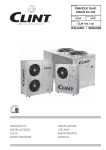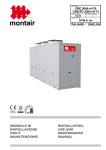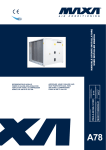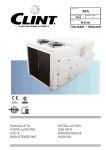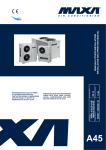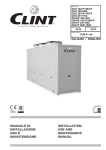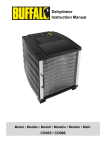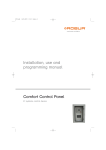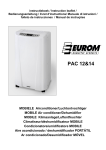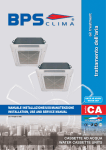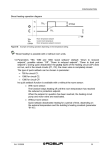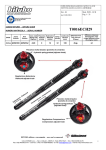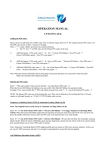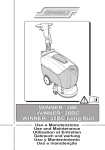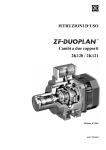Download HWA HWA/WP series
Transcript
Serie / Series / Serie / Serie HWA Emissione / Issue Ausgabe / Emission 2.04 Sostituisce / Supersede Ersetzt / Remplace 10.03 Catalogo / Catalogue / Katalog / Catalogue Gennaio 04 ITALIANO / ENGLISH Serie HWA HWA/WP - HWA REFRIGERATORI D’ACQUA ARIA/ACQUA CON VENTILATORI ASSIALI DA 5 kW A 40 kW MANUALE DI INSTALLAZIONE USO E MANUTENZIONE HWA/WP series AIRCOOLED LIQUID CHILLER WITH AXIAL FANS FROM 5 kW TO 40 kW INSTALLATION, USE AND MANTEINANCE MANUAL 0. ELENCO DOCUMENTI ALLEGATI Elenco documentazione fornita a corredo della macchina facente parte integrante del presente manuale. 2 0. LIST OF ATTACHMENTS List of documents supplied with the unit and forming an integral part of this manual. - Schema idraulico - Water connection diagram - Schema elettrico - Wiring diagram - Disegno dimensionale - Scale drawing - Programmazione microprocessore - Microprocessor programming - Manuale microprocessore - Microprocessor manual - Istruzioni varie elettriche - Various electrical instructions - Istruzioni varie elettroniche - Various electronic instructions - Certificato di garanzia - Certificate of guarantee - Dichiarazione di conformità - Declaration of conformity INDICE Argomento CONTENTS Subject Pag. Page 0 ELENCO DOCUMENTI ALLEGATI 2 0 LIST OF ATTACHMENTS 2 1 PREMESSA 5 1 INTRODUCTION 5 1.1 1.2 1.3 Informazioni generali Allegati Avvertenze 5 5 5 1.1 1.2 1.3 General information Attachments Warnings 5 5 5 2 DESCRIZIONE DELLA MACCHINA 7 2 UNIT DESCRIPTION 7 2.1 2.1.1 2.1.2 2.2 2.3 2.4 2.5 Identificazione Identificazione della macchina Codice di identificazione Destinazione d'uso Controindicazioni Descrizione generale Limiti di funzionamento 7 7 8 8 9 9 9 2.1 2.1.1 2.1.2 2.2 2.3 2.4 2.5 Identification Identification Identity code Intended use Contraindications General description Operating limits 7 7 8 8 9 9 9 3 SICUREZZA 10 3 SAFETY 10 10 11 11 12 13 13 13 14 3.1 3.2 3.3 3.3.1 3.3.2 3.4 3.5 3.5.1 3.5.2 Definizioni Regole generali di sicurezza Simbologia Mappa dei segnali di sicurezza Segnali di sicurezza Dispositivi di emergenza e di sicurezza Descrizione del rischio residuo Rischio residuo in prossimità della macchina Misure da adottare in caso di fuoriuscita di gas frigorigeno 3.5.3 Operazioni con rimozione dei pannelli 3.1 3.2 3.3 3.3.1 3.3.2 3.4 3.5 3.5.1 3.5.2 14 Definition General safety regulations Symbols Location of safety signs Safety signs Emergency and safety devices Description of residue risks Residue risks near the unit Measures to take in case of leaking refrigerant gas 3.5.3 Operations with the panels removed 10 10 10 11 11 12 13 13 13 14 14 4 ISPEZIONE, TRASPORTO 15 4 INSPECTION AND TRANSPORT 15 4.1 4.2 4.3 4.4 Ispezione Stoccaggio Sollevamento e trasporto Disimballo 15 15 16 16 4.1 4.2 4.3 4.4 Inspection Storage Lifting and transport Unpacking 15 15 16 16 5 INSTALLAZIONE 17 5 INSTALLATION 17 5.1 5.2 Scelta del luogo di installazione Collegamento idraulico 17 18 5.1 5.2 Choosing the installation site Water connections 17 18 3 Generalità Evaporatore Collegamenti elettrici Generalità Collegamento elettrico della pompa di circolazione 5.3.3 Consensi esterni 5.2.1 5.2.2 5.3 5.3.1 5.3.2 18 19 20 20 21 5.2.1 5.2.2 5.3 5.3.1 5.3.2 5.3.3 General Evaporator Electrical connections General Electrical connections to the circulation pump External signals 18 19 20 20 21 21 21 6 AVVIAMENTO 22 6 START UP 22 6.1 6.2 6.3 6.3.1 6.3.2 22 24 25 25 6.1 6.2 6.3 6.3.1 6.3.2 26 26 6.4 Preliminary controls Start up Checks during unit operation General Defrosting (Only heat pump units) Stopping the unit 22 24 25 25 6.4 Controlli preliminari all'avviamento Messa in funzione Verifiche durante il funzionamento Generalità Sbrinamento (Solo unità pompa di calore) Arresto del gruppo 7 FUNZIONAMENTO 27 7 OPERATION 27 7.1 7.2 Generalità Fermata stagionale 27 27 7.1 7.2 General Seasonal shut down 27 27 8 RICERCA GUASTI 28 8 TROUBLE SHOOTING 28 9 MANUTENZIONE E CONTROLLI PERIODI- 32 CI 9 ROUTINE MAINTENANCE AND CONTROLS 32 9.1 9.1.1 9.1.2 9.2 9.3 Avvertenze Generalità Controlli mensili Controlli quadrimestrali Riparazioni del circuito frigo Rabbocchi di refrigerante 32 32 33 33 33 33 9.1 9.1.1 9.1.2 9.2 9.3 Warnings General Monthly controls Four-monthly controls Repairing the refrigerant circuit Topping up the refrigerant liquid 32 32 33 33 33 33 10 DISMISSIONE E SMALTIMENTO 34 10 SHUT DOWN AND DISPOSAL 34 11 CIRCUITO FRIGORIFERO 35 11 REFRIGERATION CIRCUIT 35 4 26 26 1. PREMESSA 1. INTRODUCTION 1.1 INFORMAZIONI GENERALI 1.1 GENERAL INFORMATION Questo manuale contiene le norme di installazione, uso e manutenzione dei refrigeratori HWA, evidenziandone rischi e pericoli connessi. Esso è stato espressamente studiato e sviluppato per permettere al personale preposto un utilizzo facile e in sicurezza dei refrigeratori d’acqua HWA. Leggere attentamente e completamente tutte le informazioni in esso riportate. Prestare particolare attenzione alle norme evidenziate con This manual contains the installation, use and maintenance instructions for the HWA chillers, and highlights all connected risks and perils. It has been expressly prepared and written to allow authorised users to use the HWA water chillers in complete safety and with the greatest of ease. Please read the whole of this manual with care, paying special attention to the sections marked with in quanto se non osservate possono causare danno alle persone, all’ambiente e/o alla macchina stessa. La società declina ogni responsabilità per qualsiasi uso improprio della macchina, per modifiche alla stessa non autorizzate o per la non osservanza delle norme riportate sul manuale. Il manuale deve essere conservato il luogo sicuro e messo a disposizione del personale addetto alla conduzione ed alla manutenzione del refrigeratore. as non-compliance may cause harm to people, deteriorate the environment and/or damage the unit. The company declines all responsibility for any improper use of the unit, unauthorised modifications or non-compliance with the instructions contained in this manual. Please keep this manual in a safe place and make it available to chiller operators and maintenance men. 1.2 1.2 ALLEGATI ATTACHMENTS Fanno parte integrale del presente manuale i documenti evidenziati a pag. 2. The documents shown on page 2 form an integral part of this manual. 1.3 1.3 AVVERTENZE Le unità HWA sono state progettate e costruite per garantire nel tempo grande affidabilità di esercizio e massima sicurezza; per questo e grazie alle scelte progettuali e realizzative, la società può garantire la totale conformità agli standard di sicurezza CE. Ulteriore garanzia è assicurata dai collaudi cui la macchina è stata sottoposta in fabbrica. All’utente resta quindi soltanto l’impegno di un uso proprio e di una manutenzione preventiva conforme alle indicazioni contenute in questo manuale. Ogni intervento, di qualsiasi natura, sulla macchina deve essere preceduto da una attenta lettura del presente manuale in tutte le sue parti. WARNINGS The HWA units have been designed and built to ensure long-term operating reliability and maximum safety; for this reason and thanks to the company’s design and construction policy, the company is able to guarantee that this product totally complies with EC safety standards. A further guarantee of this is provided by the factory tests carried out on the unit. The user, therefore, must only ensure the unit is properly used and that maintenance operations are carried out according to the indications contained in this manual. The unit should not be touched until the whole of this manual has been carefully read. 5 Il manuale di installazione, uso e manutenzione deve essere sempre a disposizione degli addetti, i quali, prima di ogni operazione sulla macchina, devono obbligatoriamente leggerlo. Per ogni ulteriore informazione e chiarimento la MAXA S.r.l. si rende disponibile al seguente indirizzo: MAXA S.r.l. 37047 San Bonifacio (VR) - Italia Via Villabella, 23/a-b Tel. +39 045 6100969 Fax +39 045 6101851 www.maxa.it 6 This installation, use and maintenance manual must always be kept within easy reach of authorised staff who are obliged to read it before carrying out any operations on the unit. For any further information or explanations please contact MAXA S.r.l. at the following address: MAXA S.r.l. 37047 San Bonifacio (VR) - Italia Via Villabella, 23/a-b Tel. +39 045 6100969 Fax +39 045 6101851 www.maxa.it 2 DESCRIZIONE DELLA MACCHINA 2 UNIT DESCRIPTION Questo capitolo ha lo scopo di fornire una descrizione generale delle caratteristiche principali della macchina nel suo insieme, unitamente a quella dei principali componenti, standard e opzionali. This chapter contains a general description of the main unit characteristics, together with those of its principal standard and optional components. 2.1 2.1 IDENTIFICAZIONE IDENTIFICATION 2.1.1 Identificazione della macchina 2.1.1 Unit identification La macchina si identifica tramite le targhette poste sul telaio e sul quadro elettrico. Le targhette riportano i seguenti dati: The unit can be identified throug the plats attached on the frame and in the electrical box. This label contains the following information: - - Ragione sociale del costruttore Indirizzo del costruttore Designazione della serie e del tipo di unità Numero di matricola Anno di costruzione Tipo e quantità di refrigerante Massima pressione ammissibile Taratura dei pressostati Simbolo della certificazione CE Caratteristiche elettriche Identificazione schema elettrico Manufacturer’s name Manufacturer’s address Description of the series and type of unit Series number Year of construction Type and quantity of refrigerant liquid Max. Allowable pressure Pressure switch set point EC certification symbol Electrical characteristics Wiring diagram identification Manufactured by BV.ITA.40.02.1230 Modello/Model Modell/Modèle Matricola/Serial number Matrikelnr/Matricule Tensioni-Fasi-Frequenza Voltage-Phases-Frequency Spannung-Phasen-Frequenz Tension-Phases-Fréquence Tensioni circuiti ausiliari Auxiliary circuit voltage Hilfstromkreisspannung Tension circuits auxiliaires Corrente massima assorbita Max absorbed current Maximale Stromaufnahme Corrente massima di spunto Max starting current Max Anlaufstrom V Courant maxi absorbée Courant maxi de démarrage A Tipo di refrigerante Refrigerant type Kältemittel Typ Type de réfrigerant Taratura pressostato di alta High pressure switch setting HD-Wächter Einstellung Préssion maxi refrigerant bar Gruppo del fluido frigorifero Group of the refrigerant fluid Kältemittel Klasse Groupe de fluide frigorifique Manufactured by BV.ITA.40.02.1230 DIRETTIVA 97/23/CE del 29 maggio 1997 (P.E.D.) cat I A Carica refrigerante per circuito Refrigerant charge per circuit Kältemittelfüllung pro Kreislauf Charge de réfrigerant chaque circuit kg Press. massima circuito idraulico Max hydraulic circuit pressure Max. Druck im hydraul. Kreislauf Préssion maxi circuit hydraulique bar Data di produzione Manufacturing date Herstellungsdatum Date de fabrication Modello/Model Modell/Modèle Matricola/Serial number Matrikelnr/Matricule Anno di costruzione Construction year Baujahr Année de fabrication ALTA ALTA HIGH PRESS. PRESS. HIGH HOCHDUCK HOCHDUCK HAUTE HAUTE PS Max.Press.ammissibile BASSA Max Working press.Refrig.side BASSA LOW LOW PRESS. PRESS. NIEDERDUCK Max Betriebsdruck Kältemittelseitug NIEDERDUCK BASSE BASSE Press.max.de travail cute refrigerant 28bar bar 20bar bar 7 2.1.2 Codice di identificazione 2.1.2 Identity code Al fine di individuare più nel dettaglio le caratteristiche della macchina, di seguito viene fornita la decodifica della sigla di identificazione della stessa: In order to identify the characteristics of the unit in more detail, the identity code is explained as follows: HWA 1 3 41 SP HWA 4 5 6 1 3 41 SP 4 5 6 1 HW Refrigeratore d'acqua 1 HW Water Chiller 3 A C Ventilatore elicoidale Ventilatore centrifugo 3 A C Axial fan Centrifugal fan 3 A W Condensazione ad aria Condensazione ad acqua 3 A W Air condensed Water condensed 4 4 Potenza nominale compressori [HP] 4 4 Nominal power compressors [HP] 5 1 N° compressori 5 1 Number of compressors Versioni: Con serbatoio e pompa Pompa di calore 6 SP WP SP WP Versions: With tank and pump Heat pump 6 2.2 DESTINAZIONE D’USO I HWA sono refrigeratori con condensazione ad aria destinati a raffreddare acqua (eventualmente addizionata con glicole etilenico inibito) che circola in un anello chiuso. Le unità a pompa di calore (HWA...WP) possono, a seconda del ciclo di funzionamento scelto, raffreddare o riscaldare l’acqua dell’anello. Il caldo, o il freddo, così prodotto può essere utilizzato per impianti di climatizzazione o per processi industriali. 8 2.2 INTENDED USE The HWA series of air condensation chillers have been designed to cool water (possibly containing inhibited ethylene glycol) circulating in a closed circuit. The heat pump units (HWA...WP) can cool or heat the water in the closed circuit depending on which operating cycle is chosen. The heat or cold produced can be used for air-conditioning systems or industrial processes. 2.3 2.3 CONTROINDICAZIONI CONTRAINDICATIONS Non impiegare in prossimità della macchina prodotti infiammabili. Do not use inflammable products near the unit. Non impiegare in prossimità della macchina sostanze in grado di formare miscele esplosive. Do not use substances that can form explosive mixtures near the unit. Non impiegare la macchina dove sussistono problemi di impatto ambientale (vedi punto 3.5 pag. 13). Do not use the unit in conditions that could be harmful for the environment (see point 3.5 on page 13). 2.4 2.4 DESCRIZIONE GENERALE GENERAL DESCRIPTION Tutte le strutture sono realizzate in peraluman. La struttura è autoportante ed i pannelli sono facilmente rimovibili in modo da permettere l’accesso all’interno della unità per le operazioni di manutenzione e riparazione. Gli schemi funzionali e la componentistica usata sono allegati. All the unit structures are made from peraluman. The structure is free standing and the panels are easy to remove in order to allow access to the inside of the unit for maintenance and repair operations. The functional diagrams and the components used are attached to this manual. 2.5 2.5 LIMITI DI FUNZIONAMENTO Unità caricate con R407C OPERATING LIMITS Units charged with R407C 40 Funzionamento ammesso solo con acqua glicolata 30 Operation only permitted with glycolated water Funzionamento normale Normal operation 20 10 0 Funzionamento ammesso solo con acqua glicolata e controllo di condensazione (opzionale) Funzionamento ammesso solo per unità dotate di controllo di condensazione (opzionale) -10 -15 Operation only permitted with glycolated water and condensation control unit (optional accessory) Operation only permitted for units fitted with condensation control unit (optional accessory) Temperatura bulbo unido aria (°C) Wet bulb air temperature (°C) Temperatura aria (C°) / Air temperaure 50 20 10 Zona di funzionamento Operating area 0 -10 -20 -20 -5 0 5 10 20 15 Refrigeratore e pompa di calore in ciclo di raffreddamento Chiller and heat pump in cooling cycle TEMPERATURA USCITA ACQUA EVAPORATORE WATER TEMPERATURE LEAVING EVAPORATOR TEMPERATURA ARIA ESTERNA (dew point) TEMPERATURE AIR EXTERNE (dew point) SALTO TERMICO ACQUA EVAPORATORE TEMPERATURE DIFFERENCE WATER IN/OUT EVAPORATOR 30 40 50 60 Temperatura acqua riscaldata (°C) Heated water temperature (°C) Temperatura acqua refrigerata (C°) / Chilled water temperature Pompa di calore ciclo riscaldamento Heat pump in heating circuit Max. min. Max. min. Max. min. [°C] [°C] [°C] [°C] [°C] [°C] COOLING RAFFREDDAMENTO 15 5 46 10 9 3 HEATING RISCALDAMENTO 50 30 20 w.b./b.u. -10 w.b./b.u. 10 3 9 3 SICUREZZA 3 SAFETY 3.1 DEFINIZIONI 3.1 DEFINITION In questo documento verranno utilizzate le seguenti definizioni: - Zone pericolose: qualsiasi zona all’interno e/o in prossimità della macchina in cui la presenza di una persona esposta costituisca un rischio per la sicurezza e la salute di detta persona. - Persona esposta: qualsiasi persona che si trovi internamente o in parte in una zona pericolosa. - Operatore/Manutentore: la o le persone incaricate di far funzionare, regolare, eseguire la manutenzione, riparare, movimentare la macchina. This document uses the following definitions: 3.2 3.2 REGOLE GENERALI DI SICUREZZA - Dangerous areas: any area inside and/or near to the unit in which the presence of a person would give rise to a risk for that person’s health. - Exposed person: anyone who is wholly or partly inside a dangerous area. - Operator/Maintenance man: person or persons authorised to operate, adjust, service, repair or move the unit. GENERAL SAFETY REGULATIONS È vietato alle persone non autorizzate avvicinarsi alla macchina. It is forbidden for unauthorised persons to approach the unit. Prima di ogni intervento di manutenzione sulla macchina, seguire scrupolosamente quanto indicato nel capitolo 9 a pag. 32. Scrupulously observe the contents of Chapter 9 on page 32 before carrying out each maintenance operation on the unit. È vietato l’ingresso all’interno della macchina. L’accesso è consentito solo al personale qualificato e solo a macchina ferma. It is forbidden to enter the unit. Access is only permitted to qualified staff when the unit is disconnected. È vietata la rimozione delle protezioni e l’esclusione dei dispositivi di sicurezze e di emergenza. It is forbidden to remove safety guards and by-pass safety and emergency devices. È vietato stazionare sulla macchina. It is forbidden to stand on the unit. - Impiegare la macchina solo per l’uso a cui essa è destinata. - Only use the unit to do what it was built for. - Il costruttore non risponde dei danni derivanti da un impiego improprio della macchina o da modifiche tecniche effettuate sulla macchina. - The manufacturer declines all responsibility for damage deriving from improper use or technical modifications made to the unit. - Controllare regolarmente se i dispositivi di sicurezza presentano un funzionamento corretto. - Check the safety devices are in perfect working order on a regular basis. - Non smontare, modificare o mettere fuori funzione parti della macchina. - Do not dismount, modify or disconnect unit parts. - Per tutti gli interventi da effettuare sulla macchina, utilizzare esclusivamente attrezzi ed equipaggiamenti idonei e in buone condizioni. Gli operatori dovranno indossare i normali dispositivi di protezione individuali (guanti, casco, occhiali, ecc.). 10 - When working on the unit, only use suitable tools and equipment in good condition. Operators must wear normal personal protection equipment (gloves, helmet, goggles, etc.). - I lavori sull’equipaggiamento elettrico devono essere eseguiti solo da un elettricista qualificato. - Work on the electrical system of the unit may only be carried out by a qualified electrician. - Gli interventi sul circuito frigorifero possono essere effettuati solo da personale specializzato. - Work on the refrigerant circuit may only be carried out by specialised staff. 3.3 3.3 SIMBOLOGIA SYMBOLS Verificare periodicamente lo stato delle targhette e provvedere, in caso di necessità, al loro ripristino. Check the state of the plates on a regular basis and repair them if necessary. 3.3.1 Mappa dei segnali di sicurezza 3.3.1 Location of safety signs 4 6 5 1 3 2 11 3.3.2 Segnali di sicurezza 3.3.2 Safety signs 1 ATTENZIONE ♦ DARE TENSIONE AI RISCALDATORI OLIO DEL CARTER ALMENO 12 ORE PRIMA DELL’AVVIAMENTO DELL’ UNITÀ. NEGLI INTERVALLI DI FUNZIONAMENTO (AD ES. PAUSA DEL FINE SETTIMANA) TOGLIERE L’ALIMENTAZIONE ELETTRICA. ♦ L’UNITÀ É MUNITA DI UN RITARDATORE ANTIRICICLO E DI DISPOSITIVO PER LA RIPARTENZA AUTOMATICA. ♦ PRIMA DI APRIRE IL SEZIONATORE FERMARE L’UNITÀ AGENDO SUGLI APPOSITI INTERRUTTORI DI MARCIA O IN ASSENZA SUL COMANDO A DISTANZA. ♦ PRIMA DI ACCEDERE A PARTI INTERNE DELL’UNITÀ TOGLIERE TENSIONE APRENDO IL SEZIONATORE GENERALE. WARNING • SUPPLY THE CRANKCASE HEATERS AT LEAST 12 HOURS BEFORE STARTING THE UNIT. DURING TMPORARY STOP PERIODS (LIKE WEEK-ENDS) NEVER DISCONNECT ELECTRICAL SUPPLY TO THE UNIT. • THE UNIT IS PROVIDED WITH DELAY RELAY AND WITH AUTOMATIC RESTART DEVICE. • BEFORE OPENING THE MAIN SWITCH, STOP THE UNIT BY ACTING ON THE SUITABLE RUNNING SWITCHES OR,THESE ARE IF NOT PRESENT, ON THE REMOTE CONTROL. • BEFORE SERVICING THE INNER COMPONENTS, DISCONNECT ELECTRICAL SUPPLY BY OPENING THE MAIN SWITCH. ACHTUNG ◊ DIE KURBELWANNENHEIZUNG MINDESTENS 12 STUNDEN VOR DER INBETRIEBNAHME DES GERÄTS UNTER SPANNUNG SETZEN. DIE KURBELWANNENHEIZUNG WÄHREND DER STILLSTANDSZEITEN DES GERÄTS NICHT AUSSCHALTEN. ◊ DAS GERÄT IST MIT SCHALTVERZÖGERUNGSTIMER UND VORRICHTUNG FÜR AUTOMATISCHEN WIEDERANLAUF AUSGESTATTET. ◊ VOR DEM ÖFFNEN DES HAUPTSCHALTERS SETZEN SIE DAS GERÄT DURCH BETÄTIGUNG DER ENTSPRECHENDEN BETRIEBSSCHALTER ODER, WENN DIESE NICHT VORHANDEN SIND, DURCH FERNBEDIENUNG AUSSER BETRIEB. ◊ BEVOR MAN DIE INTERNE GERÄTEKOMPONENTEN BERÜHRT, MUSS DER HAUPTSCHALTER GEÖFFNET WERDEN. NOTICE ! FOURNIR TENSION AUX RÉCHAUFFERS DU CARTER AU MOINS 12 HEURES AVANT QUE L’UNITÉ SOIT DÉMARRÉE. NE COUPEZ PAS LA TENSION AUX RÉCHAFFEURS PENDANTS DES COURTES PERIODES D’ARRET DE L’UNITÉ, TELS QUE LE WEEK-END. ! L’UNITÉ EST EQUIPPÉE DE RELAIS ANTI COURT-CYCLE ET D’UN DISPOSITIF POUR LE REDÉMARRAGE AUTOMATIQUE. ! AVANT D’OUVRIR LE SÉCTIONNEUR G ÉNÉRAL, ARRETEZ L’UNITÉ EN AGISSANT SUR LES INTERRUPTEURS DE MARCHE OÙ, AU CAS OÙ IL N’Y A PAS, SUR LE COMMENDE À DISTANCE. ! AVANT DE TOUCHER LES COMPOSANT INTERNES A L’UNITÉ, COUPER LA TENSION EN OUVRANT LE SECTIONNEUR GÉNÉRAL. INGRESSO ACQUA REFRIGERATA CHILLED WATER INLET KALTWASSEREINTRITT ENTRÉE EAU GLACÉE 2 USCITA ACQUA REFRIGERATA CHILLED WATER OUTLET KALTWASSERAUSTRITT SORTIE EAU GLACÉE 3 SFIATO ARIA AIR PURGE ENTLÜFTUNGSVENTIL PURGE AIR 6 5 - PRESENZA DI ORGANI IN MOVIMENTO - PRESENCE OF MOVING OBJECTS - ANWESENHEIT VON GEGENSTÄNDEN IN BEWEGUNG - PRESENCE DES ORGANS EN MOUVEMENT 12 4 3.4 DISPOSITIVI DI EMERGENZA E DI SICUREZZA 3.4 An emergency external circuit breaker must be fitted by the unit installer to disconnect the unit from the power supply. Un dispositivo di emergenza che tolga tensione dalla macchina deve essere previsto all’esterno della stessa a cura di chi installa la macchina. 3.5 DESCRIZIONE DEL RISCHIO RESIDUO EMERGENCY AND SAFETY DEVICES 3.5 DESCRIPTION OF RESIDUE RISKS La descrizione del rischio residuo prende in considerazione i seguenti elementi: The description of residue risks includes the following elements: - a quale tipologia di pericoli è soggetto chi opera nell’ambito della macchina; - la descrizione dei principali pericoli; - chi può essere esposto a tali pericoli; - quali sono le principali misure di sicurezza adottate per ridurre il rischio di infortuni. - the kind of danger the people working on the unit are subjected to; - description of the main dangers; - who is exposed to such dangers; - the main safety methods used to reduce the risk of injury. Le indicazioni per la prevenzione degli infortuni di seguito riportate, con riferimento alle relative aree a rischio residuo, devono essere integrate con tutte le indicazioni generali del presente capitolo e con le norme di prevenzione infortuni vigenti nel paese di destinazione dell’impianto. The following accident prevention instructions, with reference to the relative areas concerned by residue risks, must be integrated with all the general indications contained in the present chapter and with the accident prevention regulations in force in the country of installation. 3.5.1 Rischio residuo in prossimità della macchina 3.5.1 Residue risks near the unit - Folgorazione, se non vengono effettuati correttamente l’allacciamento elettrico e la messa a terra della macchina. - Tagli o escoriazioni per la presenza di superfici taglienti. - Aspirazione e successiva dispersione in ambiente delle sostanze presenti sul luogo dell’installazione. - Proiezione di eventuali oggetti che possano cadere sulle pale dei ventilatori. - Fuoriuscita di acqua (in caso di anomalia). - Formazione di acqua di condensa e di ghiaccio nella zona antistante la macchina durante il funzionamento in riscaldamento delle macchine a pompa di calore. - Alterazione del microclima (durante il funzionamento). - Emissione di rumore (durante il funzionamento). - Fuoriuscita di olii (per anomalia). - Fuoriuscita del frigorigeno (per anomalia). N.B. Il frigorigeno è una sostanza ad effetto serra. Si tratta di vapori più pesanti dell’aria e che possono provocare soffocamento riducendo l’ossigeno disponibile per la respirazione. Una rapida evaporazione del liquido può causare congelamento. - Electrocution if the unit is not properly corrected to the mains power supply and earth circuit. - Cuts or abrasions caused by sharp surfaces. - Extraction and subsequent dispersion in the environment of substances present in the installation site. - Ejection of objects falling on the fan blades. - Leaking water (in case of malfunction). - Formation of condensation and ice in front of the unit while the unit heat pumps are working. - Alteration of the micro climate (during operation). - Noise (during operation). - Leaking oil (in case of malfunction). - Leaking refrigerant liquid (in case of malfunction). N.B. Refrigerant liquid is a substance which causes a greenhouse effect. Its vapours are heavier than air and can cause suffocation by reducing the amount of oxygen available for breathing. Rapid evaporation of the liquid can cause freezing to occur. 13 3.5.2 Misure da adottare in caso di fuoriuscita di gas frigorigeno 3.5.2 Measures to take in case of leaking refrigerant gas - Tipo di prodotto: R407C - Product type: R407C - Misure di pronto soccorso: Informazione generale: non somministrare alcunchè a persone svenute. Inalazione: portare all’aria aperta. Ricorrere all’ossigeno o alla respirazione artificiale se necessario. Non somministrare adrenalina o sostanze similari. Contatto con gli occhi: sciacquare accuratamente ed abbondantemente con acqua per almeno 15 minuti e rivolgersi ad un medico. Contatto con la pelle: Lavare subito abbondantemente con acqua. Togliersi immediatamente tutti gli indumenti contaminati. - First aid measures: General information: Do not give anything to people who have fainted. Inhalation: take the person out into the open air. Use oxygen or artificial respiration if necessary. Do not give adrenaline or similar substances. Contact with eyes: carefully rinse with abundant water for at least 15 minutes and see a doctor. Contact with the skin: Wash with abundant water and remove all contaminated clothing immediately. - Misure in caso di fuoriuscita accidentale: Precauzioni individuali: evacuare il personale in aree di sicurezza. Prevedere una ventilazione adeguata. Usare mezzi di protezione personali. Precauzioni ambientali: intercettare l'emissione. Metodi di pulizia: impegare prodotti assorbenti. - Measures to take in case of accidental leaking: Personal precautions: evacuate all staff to safety areas. Make sure the area is suitably ventilated. Use personal protection equipment. Environmental precautions: to intercept the emission. Cleaning methods: to employ absorbent products. 3.5.3 Operazioni con rimozione dei pannelli 3.5.3 Operations with the panels removed Alcune delle operazioni e/o verifiche di seguito descritte richiedono la rimozione dei pannelli del refrigeratore per accedere all’interno dello stesso. Prima di rimuovere qualsiasi pannello perimetrale, eccezion fatta per quello che protegge il quadro elettrico (facilmente riconoscibile dalle griglie di presa d’aria), è obbligatorio togliere tensione. Si fa presente che all’interno dell’unità, anche a macchina ferma possono esserci superfici calde (tubazioni, compressore, ecc.), o fredde (compressore, separatore d’aspirazione, ecc.), taglienti (alette batterie) o corpi in movimento (ventilatori). Pertanto tali operazioni devono essere effettuate solo da personale qualificato che indossi indumenti di sicurezza. 14 Some of the following operations and/or controls require the panels of the unit to be removed in order to access the inside of the unit. Before removing an outer panel, except for the one protecting the electrical panel (easy to recognise due to its ventilation slits), the unit must be disconnected from the mains power supply. Please note that some surfaces inside the unit may be hot (piping, compressor, etc.), cold (compressor, suction separator, etc.), sharp (coil fins) or moving (fans) even when the unit is not working. These operations may only be carried out by qualified staff wearing safety clothing. Verifiche di funzionamento possono richiedere il funzionamento (totale o parziale dell’unità) con un pannello aperto. In tal caso il pannello va rimosso a macchina ferma. Operating checks may require the unit to work (totally or partially) while a panel is open. In this case the panel should be removed when the unit is not working. Queste verifiche sono particolarmente pericolose e sono pertanto riservate a personale altamente qualificato. These checks are particularly dangerous and may only be carried out by highly qualified staff. Operare come segue: Proceed as follows: - Togliere tensione tramite l’interruttore generale. - Aprire il quadro elettrico e disattivare, togliendo i relativi fusibili, gli organi di cui non è necessario il funzionamento per la verifica che si deve effettuare. - Richiudere il quadro elettrico. - Rimuovere il pannello interessato. - Avviare l’unità. - Effettuare le verifiche richieste con la massima cautela e con l’utilizzo di protezioni individuali. - Completate le verifiche, arrestare l’unità e rimettere al suo posto il pannello precedentemente tolto. - Togliere tensione e rimettere al loro posto gli eventuali fusibili precedentemente tolti. - Richiudere il quadro elettrico. - Turn off mains power with the main power switch. - Open the electrical panel and remove the relative fuses to disconnect the components that do not need to be working in order to carry out the relative check. 4. ISPEZIONE, TRASPORTO 4. INSPECTION AND TRANSPORT 4.1 ISPEZIONE 4.1 INSPECTION - Close the electrical panel. Remove the panel in question. Start the unit. Carry out the relative check with the greatest of care and using personal protection equipment. - After completing the check, stop the unit and put the panel back in place. - Turn off mains power and put back any fuses that were previously removed. - Close the electrical panel. All’atto del ricevimento dell’unità, verificarne l’integrità. Poiché la macchina è stata accuratamente controllata prima di lasciare la fabbrica, eventuali danni sono da imputare al trasportatore. Si raccomanda perciò di annotarli sul Foglio di Consegna prima di controfirmarlo. Avvisare tempestivamente la società o l’Agente sull’entità del danno riportato dall’unità. Il Cliente deve sempre compilare un rapporto scritto che riguarda ogni eventuale danno subito dalla macchina. Check the condition of the unit on receipt. As the unit was carefully checked before leaving the factory, any claims for damages should be addressed to the forwarder. Any damage should therefore be indicated on the Delivery Note before signing it. Please inform the company or the Agent of the nature of the damage to the unit immediately. The Customer must always write a report describing any damage caused to the unit. 4.2 4.2 STOCCAGGIO La temperatura dell’ambiente in cui vengono immagazzinate le unità deve essere compresa tra -20 e +50°C. STORAGE The temperature in the area where the units are stored must range between -20 and +50°C. 15 4.3 SOLLEVAMENTO E TRASPORTO Durante lo scarico ed il posizionamento dell’unità, prestare molta attenzione alle manovre che non devono in alcun modo essere brusche e/o violente. Non utilizzare come punti di sollevamento le tubature o altri componenti della macchina. 4.3 When unloading and positioning the unit, take great care not to make sudden and/or violent manoeuvres. Do not lift the unit by its piping or any other components. The unit should only be moved as shown in the plate attached to it. Attenzione! In tutte le operazioni di sollevamento assicurarsi di aver ancorato saldamente l’unità per evitare ribaltamenti o cadute accidentali. 4.4 DISIMBALLO L’imballo va tolto solo quando l’unità è giunta sul posto di installazione e non dovrà più essere movimentata. Rimuovere con cura l’imballo della macchina, evitando di danneggiare la stessa. Poiché i materiali che costituiscono l’imballo sono di natura diversa (legno, nylon, polistirolo, cartone, ecc.), si consiglia di conservarli separatamente e di consegnarli alle ditte specializzate nello smaltimento e nel riciclaggio degli stessi allo scopo di salvaguardare l’ambiente. 16 LIFTING AND TRANSPORT Attention! Make sure the unit is securely anchored before lifting it in order to prevent it from accidentally overturning or falling. 4.4 UNPACKING Only unpack the unit when it has reached the installation site and no longer needs to be moved. Remove the packing material with care, making sure not to damage the unit. Given that various kinds of packing materials are used (wood, nylon, polystyrene, cardboard, etc.), they should be separated and delivered to specialised disposal and recycling companies for environmental reasons. 5 INSTALLAZIONE 5 INSTALLATION 5.1 SCELTA DEL LUOGO DI INSTALLAZIONE 5.1 CHOOSING THE INSTALLATION SITE Nella scelta del luogo di installazione si dovrà tenere conto di: - Peso dell’unità: La soletta di appoggio dell’unità deve essere perfettamente orizzontale ed in grado di sopportare il peso in funzionamento dell’unità. È opportuno costruire una soletta di supporto di dimensioni proporzionate all’unità. Ciò si rende in particolar modo necessario quando l’unità deve essere posta su terreno instabile (giardini, terreni di riporto, ecc.). La soletta deve: • appoggiare su opportune fondamenta, avere un’altezza, rispetto al terreno circostante, di circa 10-15 cm; • essere orizzontale ed in grado di sopportare circa il 200% del peso di esercizio della macchina. Si consiglia di interporre una guarnizione di sughero adeguatamente sigillata lungo il perimetro. - Spazi: È necessario verificare che gli spazi di rispetto riportati sul foglio dimensionale dell’unità siano lasciati liberi. Ridurre lo spazio richiesto può significare difficoltà o impossibilità di effettuare le operazioni di manutenzione e/o malfunzionamento dell’unità a causa di riduzione della portata d’aria che investe la batteria condensante o di ricircolo della stessa. Si fa presente che non sono ammessi ostacoli quali tettucci, pensiline o coperture in genere al di sopra della macchina. Si tenga presente che le unità a pompa di calore danno luogo a formazione di ghiaccio e condensa che si riversa sul pavimento antistante l’unità. Si dovrà pertanto provvedere a raccogliere e drenare l’acqua di condensa e sbrinamento per evitare che il pavimento diventi sdrucciolevole. Tutta la zona di rispetto dovrà essere interdetta, fatta eccezione per gli operatori e manutentori addetti alla macchina. - Rumore: Durante il suo funzionamento, l’unità genera del rumore, evitare pertanto l’installazione in ambienti riverberanti. L’unità dovrà essere posizionata con il lato batteria rivolto nella direzione in cui la rumorosità è meno critica. - Venti predominanti: Il vento può alterare le condizioni di funzionamento, per minimizzarne gli effetti si consiglia di posizionare l’unità con il lato lungo parallelo alla direzione dei venti predominanti. - Vibrazioni: Benché le macchine trasmettano al terreno un basso livello di vibrazioni, è in ogni caso consigliabile frapporre fra il basamento delle stesse ed il piano di appoggio un nastro di gomma rigido. When choosing the installation site the following points should be considered: - The weight of the unit: The supporting surface under the unit must be perfectly horizontal and able to withstand its operating weight. A supporting surface with an appropriate area should be built. This is particularly important if the unit is installed on unstable ground (gardens, embankments, etc.). The supporting surface must: • lie on suitable foundations and be about 10-15 cm higher than the surrounding ground; • be horizontal and able to withstand about 200% of the weight of the unit in operation. A suitable sealed layer of cork should be placed along the perimeter. - Spaces: Make sure that sufficient free space, as indicated on the scale drawing, is left around the unit. Less space will make it difficult or impossible to carry out maintenance operations and/or lead to faults in the unit due to the reduction in the air flow on the condenser coil or its recirculation. Please note that obstacles such as canopies, shelters or coverings in general are not permitted. Please note that the heat pump units cause ice and condensation to form and drain onto the floor in front of the unit. This water must therefore be collected and drained to prevent the floor from becoming slippery. People may not enter the unit area unless they are authorised operators and maintenance personnel. - Noise: The unit generates noise while it’s working; do not install it in reverberating rooms. The unit must be positioned with the coil side facing the direction where noise is less critical. - Prevailing winds: Wind may alter operating conditions; to minimise its effects the unit should be positioned with the long side parallel to the direction of prevailing winds. - Vibrations: Although the units transmit a low level of vibrations to the ground, a sheet of rigid rubber should always be placed between the unit base and the supporting surface. 17 Quando si rende necessario un isolamento maggiore è opportuno l’utilizzo di supporti antivibranti (in gomma o a molle 5.2 COLLEGAMENTO IDRAULICO If greater insulation is required, vibration moisting supports should be used (in rubber or with springs). 5.2 WATER CONNECTIONS 5.2.1 Generalità 5.2.1 General Per la realizzazione del circuito idraulico dell’acqua refrigerata è buona norma seguire attentamente le indicazioni sotto riportate oltre che la normativa vigente. Please carefully carry out the following instructions and observe current law when installing the chilled water circuit. Attenzione! Le tubazioni idrauliche devono essere opportunamente staffate per non gravare con il loro peso sul refrigeratore. Attention! The water pipes must be suitably supported with brackets in order not to weigh on the chiller. - Raccordare le tubazioni al refrigeratore tramite giunti flessibili al fine di evitare la trasmissione delle vibrazioni e compensare le dilatazioni termiche. - Connect the pipes to the chiller with flexible joints in order to prevent the transmission of vibrations and to compensate thermal expansion. - Installare sulle tubazioni i seguenti componenti: • valvole di intercettazione (saracinesche) per isolare l’unità dal circuito idraulico; • indicatori di temperatura e pressione per la normale manutenzione e controllo del gruppo; • pozzetti sulle tubazioni d’ingresso ed uscita per i rilievi di temperatura, qualora non fossero presenti indicatori di temperatura; • filtro metallico (tubazione in ingresso) a rete con maglia non superiore ad 1mm, per proteggere lo scambiatore da scorie o impurità presenti nelle tubazioni; • valvola di taratura per la regolazione della portata acqua • valvole di sfiato, da collocare nelle parti più elevate del circuito idraulico, per permettere lo sfogo dell’aria; • vaso di espansione, dimensionato in funzione della quantità d’acqua contenuta nell’impianto e delle escursioni termiche prevedibili, e valvole di carico automatica per il mantenimento della pressione del sistema e compensare le dilatazioni termiche del fluido. • rubinetto di scarico e, ove necessario, serbatoio di drenaggio per permettere lo svuotamento dell’impianto per le operazioni di manutenzione o le pause stagionali. - Install the following components on the pipes: • shut-off valve (moisters) for shutting off the water mains; • temperature and pressure gauges for routine maintenance and inspection purposes; • check points on the inlet and outlet pipes for measuring temperatures if temperature indicators are not fitted; • metal filter (inlet pipe) with a maximum mesh aperture of 1 mm to protect the exchanger from waste or impurities in the pipes; 18 • waterflow control valve • relief valves, fitted in the uppermost parts of the water circuit, for expelling air; • expansion tank of a suitable size for the quantity of water contained in the system and the expected temperature range, and an automatic inlet valve for maintaining the pressure of the system and compensating the thermal expansion of the fluid. • drain valve or, where necessary, drain tank for emptying the circuit for maintenance operations or seasonal shut downs. 5.2.2 Evaporatore È di importanza fondamentale che l’ingresso dell’acqua avvenga in corrispondenza della connessione contrassegnata con la targhetta “ENTRATA ACQUA”. Per gli attacchi idraulici vengono utilizzate connessioni filettate maschio o flangiate, a seconda dei modelli (fare riferimento ai disegni dimensionali, così come per la posizione degli attacchi). È di fondamentale importanza realizzare il circuito idraulico in modo tale che venga garantita la costanza della portata d’acqua allo scambiatore in qualsiasi condizione di funzionamento. 5.2.2 Evaporator It is vitally important that the water enters the unit from the connection point marked with the “WATER INLET” plate. Threaded or flanged male unions, depending on the models, are used to make water connections (please refer to the scale drawings which also show the position of the unions). It is vitally important to connect the water circuit so that the flow of water to the exchanger is always constant under all operating conditions. Poiché la richiesta frigorifera dell’utenza non coincide generalmente con quella erogata dai compressori, l’azione degli stessi è molto spesso intermittente. Negli impianti a basso contenuto d’acqua, dove l’effetto di inerzia termica della stessa è meno sensibile, è opportuno verificare che il contenuto dell’impianto soddisfi la seguente relazione: V > P/45n dove: V = volume d’acqua (litri) P = potenza resa dall’unità (Watt) n = numero di gradini di parzializzazione. As the demand for cooling by utilities does not generally coincide with what is delivered by the compressors, they often work intermittently. In units with a low water content, where the effect of thermal inertia is not felt so much, the system should be checked to make sure it satisfies the following relation: V > P/45n where: V = volume of water (litres) P = power capacity of the unit (Watts) n = number of capacity steps. Se non vengono raggiunti i volumi sopraccitati, è necessario prevedere un serbatoio d’accumulo tale che, sommato alla capacità dell’impianto, venga raggiunto il valore fornito dalla relazione riportata. Tale serbatoio non richiede particolari accorgimenti, salvo che, allo stesso modo delle tubature dell’acqua refrigerata, va isolato al fine di non penalizzare la resa dell’impianto e di evitare fenomeni di condensazione. If the above volumes are not obtained, a storage tank should be installed so as to satisfy the above relation when added to the capacity of the system. This tank requires no special features; it just needs to be isolated, just like the chilled water pipes, so as not to affect the performance of the system and to prevent the formation of condensation. È buona norma installare una valvola di sicurezza sul circuito idraulico. In caso di anomalie gravi nell’impianto (ad es. incendio) essa permetterà di scaricare il sistema evitando possibili scoppi. Collegare sempre lo scarico ad una tubazione di diametro non inferiore a quello dell’apertura della valvola, e convogliarlo in zone nelle quali il getto non possa recare danno alle persone. A safety valve should be installed on the water circuit. In case of serious system faults (e.g. fire) this will allow the system to be drained in order to prevent the risk of explosions. Always connect the drain to a pipe with a diameter not less than that of the valve opening and install the outlet in an area where the jet cannot cause harm to people. Attenzione! Durante le operazioni di allacciamento idraulico non operare mai con fiamme libere in prossimità o all’interno dell’unità. Attention! While connecting the water circuit, never work with naked flames near to or inside the unit. 19 Schema di collegamento impianto idraulico Hydraulic circuit connection diagram 11 12 2 10 T F 8 7 11 1 E 11 1 12 9 T 10 2 3 5 4 2 2 6 1 = 2 = 3 = 4 = 5 = 6 = 7 = 8 = 9 = 10= 11= 12= E = 5.3 Giunti antivibranti Valvola di intercettazione a sfera Valvola di ritegno Pompa di circolazione Filtro a rete Gruppo di carico acqua automatico Vaso di espansione chiuso Valvola di sicurezza Serbatoio di accumulo acqua Termometri Sfiato aria automatico Manometro Evaporatore COLLEGAMENTI ELETTRICI 5.3.1 Generalità 1 = 2 = 3 = 4 = 5 = 6 = 7 = 8 = 9 = 10= 11= 12= E = 5.3 2 Vibration-proof joints ball shut-off valve Check valve Circulation pump Mesh filter Automatic water filling valve Closed expansion tank Safety valve Water storage tank Thermometers Automatic air purge Pressure gauge Evaporator ELECTRICAL CONNECTIONS 5.3.1 General Queste operazioni devono essere effettuate solo da personale specializzato. These operations may only be carried out by specialised staff. Prima di effettuare qualsiasi operazione su parti elettriche assicurarsi che non vi sia tensione. Before carrying out any operations on electrical components, make sure the unit is disconnected from the mains power supply. Verificare che l’energia disponibile corrisponda ai dati nominali dell’unità riportati sulla targhetta (tensione, numero di fasi, frequenza). Make sure that the mains power supply corresponds to the rated values of the unit shown on the plate (voltage, number of phases, frequency). I collegamenti elettrici devono essere effettuati seguendo attentamente le istruzioni riportate sullo schema elettrico allegato all’unità. Il collegamento a terra è obbligatorio per legge. Si deve perciò provvedere al collegamento del cavo di terra con la barra di terra situata nel quadro elettrico e contrassegnata con PE. 20 Electrical connections must be made carefully following the instructions shown on the wiring diagram attached to the unit. The earth connection is obligatory by law. The earth cable must be connected to the earth bar located in the electrical panel and marked with PE. L’alimentazione del circuito ausiliario è derivata dalla linea di potenza tramite un trasformatore situato nel quadro elettrico. La sezione del cavo e le protezioni di linea devono essere conformi a quanto indicato nello schema elettrico e nell’apposita scheda allegata all’unità. Auxiliary circuit power is supplied by the power line by means of a transformer located in the electrical panel. The cross-section of the cable and the line protections must comply with the indications shown on the wiring diagram and in the relative sheet attached to the unit. Rispettare la sequenza delle fasi, viceversa la macchina non potrà funzionare. Observe the phase sequence, otherwise the unit will not work. La tensione di alimentazione non deve subire variazioni superiori a ±5% e lo squilibrio tra le fasi deve essere sempre inferiore al 2%. Input voltage must not exceed variations of over ±5% and phase unbalance must always be less than 2%. Il funzionamento deve avvenire entro i valori sopra citati, pena la decadenza immediata della garanzia. Unit operation must always take place within the above values as otherwise the guarantee will immediately become null and void. 5.3.2 Collegamento elettrico della pompa di circolazione 5.3.2 Electrical connections to the circulation pump La pompa di circolazione deve sempre essere collegata al controllo dell’unità come previsto dallo schema elettrico. The circulation pump must always be connected to the unit control system as shown on the wiring diagram. La pompa deve essere avviata prima della partenza del refrigeratore e fermata dopo l’arresto di quest’ultimo (ritardo minimo consigliato: 40 secondi). The pump must be started up before starting up the chiller while it must be stopped after the chiller has stopped (minimum recommended delay: 40 seconds). 5.3.3 Consensi esterni 5.3.3 External signals Qualora si desideri effettuare un ON-OFF remoto dell’unità è necessario collegare il consenso esterno ai contatti indicati sullo schema elettrico. Per il collegamento elettrico al contatto ON-OFF remoto e funzionamento CHILLER-POMPA DI CALORE remoto, non installare i cavi di comando all’interno delle canaline usate per i cavi di potenza; nel caso non fosse possibile, utilizzare un cavo schermato. If a remote ON-OFF command is required, connect the external enable to the contacts shown on the wiring diagram. For the electrical connection to the remote On-off contact and remote Chiller heat pump operation, do not install drive cables inside the ducts used for power cables; if it is not possible, a shielded cable must be used. Quando si effettuano i collegamenti descritti ai paragrafi 5.3.2 - 5.3.3 attenersi scrupolosamente a quanto riportato nello schema elettrico. I cavi di collegamento devono avere sezione minima di 1,5 mm². When making the connections described in paragraphs 5.3.2 - 5.3.3, carefully follow the indications shown in the wiring diagram. The connecting cables must have a minimum cross-section of 1,5 mm². 21 6 AVVIAMENTO 6 START UP 6.1 CONTROLLI PRELIMINARI ALL’AVVIAMENTO 6.1 PRELIMINARY CONTROLS - Verificare che i collegamenti elettrici siano stati eseguiti correttamente e che siano stati serrati tutti i morsetti. - Make sure that the electrical connections have been made correctly and that all the terminals have been well tightened. - Verificare che la tensione sui morsetti L , L , L , sia 1 2 3 quella riportata sulla targa dell’unità (tolleranza ammessa) ±5% controllabile con un tester. Se avvengono frequenti variazioni di tensione, si prega di contattare il nostro ufficio tecnico per la scelta di opportune protezioni. - Use a tester to make sure that the voltage on terminals L , L , L , is equal to that shown on the rating plate 1 2 3 (permitted tolerance ±5%). If voltage is subject to frequent variations, please contact our technical office in order to decide on suitable protection devices. - Controllare, eventualmente tramite l’ausilio di un cercafughe, che non vi siano perdite di fluido refrigerante. - Use a leak tester, if necessary to make sure there are no leaks of refrigerant liquid. - Verificare che le resistenze del carter (se presenti) siano correttamente alimentate. - Check that the heating elements of the sump (if fitted) are correctly powered. L’inserimento delle resistenze deve essere fatto almeno 12 ore prima dell’avviamento, ed avviene automaticamente alla chiusura del sezionatore generale (posizione I). The heating elements must be turned on at least 12 hours before start up; this takes place automatically when the main power switch is closed (position I). Per controllare se le resistenze funzionano correttamente, verificare che la parte inferiore del compressore sia ad una temperatura di 10÷15°C superiore a quella ambiente. To check if the heating elements work correctly, make sure that the lower part of the compressor is 10÷15°C higher than room temperature. - Verificare il corretto collegamento del circuito idraulico (devono essere rispettate le indicazioni sulle targhette a bordo macchina). - Check the water circuit is correctly connected (the indications on the unit rating plate must be observed). - Assicurarsi che il circuito idraulico sia stato preventivamente pulito: si consiglia di effettuare un lavaggio del circuito idraulico bypassando l’unità e quindi verificare lo stato di pulizia del filtro dell’impianto. - Make sure that the water circuit has been cleaned beforehand: the water circuit should be washed, bypassing the unit, and then the system filter checked for dirt. - Le macchine vengono spedite con sfiati e drenaggi aperti. Apposite targhette indicano le loro posizioni. Essi vanno chiusi all’atto dell’installazione quando si riempie il circuito idraulico. - The units are despatched with the relief valves and drains open. Special plates show where they are located. They must be closed during installation before the water circuit is filled. - Verificare che l’impianto idraulico sia stato sfiatato, eliminando ogni eventuale residuo d’aria; l’operazione va eseguita caricando gradualmente e aprendo i dispositivi di sfiato disposti dall’installatore nella parte superiore dell’impianto (a tale proposito consultare la sezione 5.2). - Make sure the water circuit has been well vented to eliminate any air residues; this operation is carried out by gradually loading and opening the relief valves fitted to the uppermost part of the unit by the installer (please consult section 5.2 for further information). 22 - Qualora si utilizzi acqua glicolata si può spostare il set point antigelo, il valore deve essere pari al valore della temperatura di congelamento del fluido più 6K.» - In case water with glycol is used, the anti-freezing set point can be moved, the value must be equal to the value of the freezing temperature of the fluid plus 6K.» - Prima di avviare la pompa è necessario controllare che le parti in movimento ruotino liberamente. A tale scopo togliere il copriventola (3) dalla sede del coperchio posteriore del motore (1) ed agire con un cacciavite sull’intaglio previsto sull’albero motore dal lato ventilazione. In caso di bloccaggio ruotare il cacciavite battendo leggermente su di esso con un martello (fig. A), rimontare il copriventola. - Before starting the pump, make sure that the moving parts turn freely. To do so, remove the fan cover (3) from the rear motor cover (1), insert a screwdriver into the notch on the ventilation side of the motor shaft and rotate it. If it blocks, rotate the screwdriver by gently hitting it with a hammer (fig. A). Then put the fan cover back. - Dare tensione e controllare, per la versione trifase, il giusto senso di rotazione, che, osservando il motore dal lato ventola, dovrà avvenire in senso orario (fig. B). In caso contrario invertire tra di loro due qualsiasi conduttori di fase. - Power the unit and check, for the three-phase version, the motor rotates clockwise, looking at it from the fan side (fig. B). If this is not the case, invert any two phase wires. Attenzione! Prima di procedere alla messa in funzione dell’unità, assicurarsi che tutti i pannelli di chiusura siano al loro posto e siano stati ben fissati con le apposite viti. Attention! Before starting up the unit, make sure that all the external panels are in place and fixed with screws. 23 6.2 MESSA IN FUNZIONE Selezionare sul controllore a micropeocessore il ciclo di funzionamento (riscaldamento o raffreddamento) tramite i tasti freccia e posizionarsi sul menu: “Selezione Modo” e selezionare “estate” (raffreddamento) o “inverno” (riscaldamento). N.B.: questa operazione è richiesta solo per le unità in versione a pompa di calore. Attenzione! La commutazione del ciclo di funzionamento dovrebbe essere effettuata stagionalmente. Frequenti passaggi dal funzionamento estivo a quello invernale e viceversa sono sconsigliati poiché possono provocare il cattivo funzionamento dei compressori con il loro conseguente danneggiamento. Avviare la macchina ed osservare che si verifichi quanto segue (le indicazioni tra parentesi si riferiscono ad unità a pompa di calore avviate in ciclo di riscaldamento). Dapprima si avvia la pompa e, se la temperatura dell’acqua di ritorno dall’impianto è sufficientemente alta (bassa), dopo circa 2½ minuti si avvieranno automaticamente i ventilatori, e dopo circa 40 secondi, il compressore. Al diminuire (aumentare) della temperatura dell’acqua di ritorno dall’impianto avverrà l’arresto del compressore. Assieme al compressore si arresteranno anche i ventilatori mentre resterà in funzione la pompa di circolazione acqua. Al risalire (riabbassarsi) della temperatura dell’acqua di ritorno dall’impianto si riavvierà il compressore e vengono avviati tutti i ventilatori. Se la macchina non si avvia, consultare il capitolo 9, parte prima. Si raccomanda di non togliere tensione all’unità durante i periodi di arresto. La tensione va tolta solo per pause prolungate (ad esempio per fermate stagionali). Per lo spegnimento temporaneo dell’unità, seguire attentamente le istruzioni riportate nel paragrafo 7. 24 6.2 START UP Select, on the microprocessor controller the operating cycle (heating or cooling) use the arrow keys to move to the: “Mode select” menu and select “summer” (cooling) or “winter” (heating). N.B.: this operation is only required for the versions with heat pump. Attention! The operating cycle should be changed on a seasonal basis. Frequent changes between summer and winter modes should be avoided as they can cause the compressors to work badly and consequently damage them. Start the unit and make sure the following happens (indications between brackets refer to units with heat pumps working in the heating cycle mode). First start the pump and, if the temperature of the returning water from the playt is high (low) enough, the fans will start up automatically after about 2½ minute, after about 40 sec. later the compressor. When the temperature of the water returning from the unit decreases (increases), the compressor will stop. The fans will stop together with the compressor while the water circulation pump will remain operating. When the temperature of the water returning from the unit increases (decreases) the compressor will start up as well as all the fans. If the unit doesn’t start, please consult chapter 9, part one. The power supply must not be switched off while the unit is stopped. Power should only be switched off for prolonged pauses (e.g. seasonal shut downs). To shut down the unit for short periods, please carefully follow the instructions shown in paragraph 7. 6.3 VERIFICHE DURANTE IL FUNZIONAMENTO 6.3 CHECKS DURING UNIT OPERATION 6.3.1 Generalità 6.3.1 General - Controllare che la macchina non generi rumori anomali o vibrazioni eccessive. - Check the unit for strange sounds or excessive vibrations. - Controllare che la sequenza precedentemente descritta si ripeta regolarmente, lasciando in funzione il compressore per almeno 10 minuti (se così non fosse si dovrà aumentare l’inerzia dell’impianto). - Check that the above sequence is repeated regularly, leaving the compressor working for at least 10 minutes (if this is not the case, unit inertia must be increases). - Dopo alcuni minuti dall’avviamento del compressore, durante il ciclo di funzionamento estivo, assicurarsi che la temperatura di condensazione sia di 18±4K superiore alla temperatura dell’aria in ingresso al condensatore e che la temperatura di evaporazione sia di circa 5K inferiore alla temperatura dell’acqua in uscita dall’evaporatore (a seconda della grandezza del refrigeratore, del gas refrigerante usato e della temperatura ambiente). - A few minutes after the compressor start during the summer operating cycle, make sure the condensation temperature is 18 ± 4K higher than the temperature of the air entering the condenser (depending on the size of the chiller, the kind of refrigerant gas used and the room temperature) and that the evaporating temperature is about 5K less than the temperature of the water leaving the evaporator. - Verificare che la temperatura del surriscaldamento del fluido frigorigeno sia compresa tra 5 e 7K. Per fare ciò, rilevare la temperatura da un termometro a contatto posto sul tubo di aspirazione del compressore e quella indicata sulla scala di un manometro connesso anch’esso in aspirazione: la loro differenza fornisce il valore del surriscaldamento. - Make sure that the overheating temperature of the refrigerant lies between 5 and 7K. Do this by measuring the temperature with a contact thermometer placed on the suction pipe of the compressor and that indicated on a pressure gauge connected to the suction line as well: the difference between the two gives the values of overheating. - Verificare che la temperatura del sottoraffreddamento del fluido frigorigeno sia compresa tra 4 e 8K. Per fare ciò, rilevare la temperatura da un termometro a contatto posto sul tubo di uscita dal condensatore e quella indicata sulla scala di un manometro connesso anch’esso sulla presa del liquido all’uscita del condensatore: la loro differenza fornisce il valore di sottoraffreddamento. - Make sure that the subcooling temperature of the refrigerant fluid lies between 4 and 8K. Do this by measuring the temperature with a contact thermometer placed on the suction pipe of the compressor and that indicated on a pressure gauge connected to the suction line as well: the difference between the two gives the values of subcooling. - Verificare, durante il funzionamento, l’assorbimento elettrico della pompa dell’acqua (ove installata): deve corrispondere a quanto indicato nello schema elettrico. In caso contrario significa che la pompa non sta lavorando in curva. - Verify, during the operation, the electrical absorption of the water pump (if installed): it must correspond to the data indicated on the wiring diagram. In contrary case it means that the pump is not working in curve. 25 6.3.2 Sbrinamento (Solo unità pompa di calore) 6.3.2 Defrosting (Only heat pump units) Durante il funzionamento in ciclo invernale (pompa di calore), la batteria lavora come evaporatore, raffreddando e deumidificando l’aria esterna. A seconda delle condizioni termoigronometriche dell’aria esterna, si avrà la formazione di condensa o di brina. La brina accumulata sulla batteria ostruisce il passaggio dell’aria, riducendo la portata della stessa e conseguentemente la resa termica. Le unità a pompa di calore sono provviste di organi di controllo che provvedono allo sbrinamento automatico della batteria qualora ve ne fosse la necessità. Tale controllo prevede una sonda di temperatura posta sulla batteria, la quale, quando la temperatura rilevata eguaglia o è inferiore al punto di taratura, attiva il consenso allo sbrinamento, che avrà luogo solo se c’è stato un intervallo di tempo minimo dall’ultimo sbrinamento. During operation in the winter cycle (heat pump), the coil works as an evaporator, cooling and dehumidifying the external air. Depending on the temperature and moisture of the external air, condensation or frost will form. The frost accumulated on the coil obstructs the air inlet thereby reducing air flow and the heat transfer rate. The heat pump units are fitted with control devices that automatically defrost the coil whenever necessary. This control device features a temperature probe placed on the coil which, when the temperature is equal to or lower than the set-point, activates the defrost cycle function which will take place only if a certain time has elapsed since the last defrosting process. Lo sbrinamento avviene nel modo seguente (le indicazioni tra parentesi si riferiscono ad unità con controllo di condensazione): - si arrestano i ventilatori; - tramite la valvola a 4 vie viene invertito il ciclo di funzionamento e facendo così funzionare la batteria alettata come condensatore. Il calore di condensazione provoca lo scioglimento della brina che si riversa a terra. Quando viene raggiunta la temperatura (pressione) impostata di fine sbrinamento, la valvola a 4 vie viene nuovamente invertita, ripristinando il ciclo di funzionamento invernale. Lo sbrinamento dura mediamente da 1 a 3 minuti e viene comunque interrotto dopo 3 minuti anche se non è stato raggiunto il valore di set-point della temperatura (pressione) di fine sbrinamento. Defrosting takes place as follows (indications between brackets refer to units with condensation control): - the fans stop; - the operating cycle is inverted with the 4-way valve, thereby making the finned coil work like a condenser. The condensation heat causes the frost to melt and drain to the ground. When the end-of-cycle temperature (pressure) is reached, the 4-way valve is inverted once more and the winter operating cycle continues. Defrosting lasts from about 1 to a maximum of 5 minutes when it is interrupted even if the end-of-cycle temperature (pressure) set-point has not been reached. 6.4 6.4 ARRESTO DEL GRUPPO La fermata del gruppo avviene premendo il tasto “OFF” posto sulla maschera del microprocessore. Attenzione! Per la fermata del gruppo non togliere tensione con l’interruttore generale poiché, così facendo, non verrebbero alimentate le resistenze del carter, con pregiudizio per l’integrità del compressore alla ripartenza. 26 STOPPING THE UNIT Stop the unit by pressing the “OFF” key placed on the microprocessor front. Attention! Do not stop the unit by turning off the main power switch as this would also disconnect the heating elements of the sump which would affect compressor operation after start up. 7 FUNZIONAMENTO 7 OPERATION 7.1 GENERALITÀ 7.1 GENERAL La macchina va avviata ed arrestata tramite il pulsante ON/OFF posto sulla mascherina del microprocessore. Compressori e ventilatori si avvieranno e si fermeranno automaticamente in funzione della temperatura dell’acqua di ritorno dall’impianto mentre la pompa di circolazione resterà in funzionamento continuo. Se qualcosa di anomalo dovesse avvenire la macchina andrà in blocco totale o parziale dando una segnalazione di allarme e visualizzando sul display del microprocessore quale delle sicurezze ha bloccato il funzionamento. Prima di ripristinare il funzionamento dell’unità si dovrà accertare ed eliminare la causa che ha generato il blocco. Per ripristinare alcune sicurezze è necessario, oltre al normale ripristino da tastiera; intervenire sull’organo di sicurezza riarmandolo. Start and stop the unit with the ON/OFF button located on the microprocessor cover. The compressors and fans will automatically start and stop depending on the temperature of the water returning from the unit while the circulation pump will remain working continuously. If a fault should occur, the unit will totally or partially block and will give an alarm signal; the microprocessor display will indicate which safety device was activated. Before resetting the unit, the reasons for the block must be identified and eliminated. Some safety devices must be reset both physically and from the keyboard. These operations must be carried out by specialised staff. IT IS FORBIDDEN TO TAMPER WITH SAFETY DEVICES. Tali operazioni devono essere effettuate da personale specializzato. È VIETATO MANOMETTERE LE SICUREZZE. 7.2 FERMATA STAGIONALE Qualora si preveda una lunga fermata dell’impianto e si voglia di conseguenza togliere tensione alla macchina, ci si dovrà accertare quale è la minima temperatura a cui può essere soggetta la macchina. Se questa è inferiore al punto di congelamento del fluido contenuto negli scambiatori, questi dovranno essere drenati. Inoltre per drenare ulteriormente l'acqua residua, utilizzare l'apposita valvolina di scarico acqua, posta sul tubo ingresso acqua evaporatore. 7.2 SEASONAL SHUT DOWN If the unit is planned to be shut down for a long time and the unit is required to be disconnected from the mains supply, the minimum temperature to which the unit may be subjected must be identified. It this is lower than the freezing point of the fluid contained in the exchangers, these must be drained. Furthermore, in order to further drain the outstanding water, use the suitable little discharge valve, placed on the pipe of the wather inlet to the evaporator. 27 8 RICERCA GUASTI PROBLEMA I. IL GRUPPO NON PARTE POSSIBILI CAUSE INTERVENTO CONSIGLIATO 1. C'è un errato collegamento oppure sono aperti i contatti 1. Controllare la sequenza delle fasi, controllare il voltaggio e chiudere i contatti. 2. Il compressore è difettoso 2. Vedere il punto II. 3. Mancano i consensi esterni 3. Verificare il funzionamento delle pompe di circolazione acqua , del 4. Manca il consenso della sonda di lavoro 4. Impianto in temperatura, mancanza di richiesta. Controllare la taratura ed 5. Manca il consenso dell'antigelo (+) 5. Verificare taratura e funzionamento. 6. Manca il consenso di un dispositivo di sicurezza (+) 6. Vedere punto IV o V. 7. È attivo il timer antiriciclo 7. Attendere circa 5 minuti. 8. Intervengono i relè termici dei ventilatori (+) 8. Vedere punto VI. 1. Il compressore è bruciato 1. Sostituirlo. 2. Il circuito di potenza è aperto 2. Chiudere l'automatico del compressore dopo avere ricercato la causa di 3. La protezione del motore è aperta (+) 3. Il compressore ha lavorato in condizioni critiche oppure la carica di 4. Il teleruttore del compressore è diseccitato 4. Ispezionare la tensione ai capi della bobina del compressore e la continuità pressostato differenziale, sfiatare l'impianto. Verificare ulteriori consensi esterni. il funzionamento. II. NON PARTE UN COMPRESSORE intervento della protezione. refrigerante è scarsa. Verificare le condizioni di lavoro e vedere il punto VII. della bobina. Sostituire se difettosa. III. PARTENZE ED ARRESTI RIPETUTI DEL COMPRESSORE 1. Il compressore è difettoso 1. Ispezionarlo ed eventualmente sostituirlo. 2. Il pressostato di minima interviene (+) 2. Vedere punto V. 3. Il teleruttore del compressore è difettoso 3. Controllare ed eventualmente sostituire. 4. Sono errati i valori di taratura del set-point 4. Modificarli facendo riferimento ai dati riportati sulla programmazione del microprocessore. 5. Manca refrigerante 5. Vedere punto VII. IV. NON PARTE UN COMPRESSORE PERCHÉ INTERVIENE IL PRESSOSTATO DI MASSIMA (+) 1. Il pressostato non funziona 1. Controllare e sostituirlo. 2. C'è un'eccessiva carica di refrigerante 2. Rimuovere l'eccesso di refrigerante dall'impianto. 3. C'è presenza di gas incondensabili nel circuito frigorifero 3. Scaricare il circuito, produrre il vuoto, quindi procedere ad una nuova carica. 4. Il filtro del refrigerante è intasato 4. Controllare e sostituirlo. 5. Sono intasati i filtri metallici (se presenti) del condensatore. 5. Pulire i filtri con aria compressa o con acqua. V. NON PARTE UN COMPRESSORE PERCHÉ INTERVIENE IL PRESSOSTATO DI MINIMA (+) La portata d'aria è troppo bassa * 6. I ventilatori del condensatore non funzionano * 6. Vedere punto VI. 7. Presenza di aria nel circuito idraulico ** 7. Sfogare il circuito idraulico. 8. La pompa di circolazione è difettosa ** 8. Controllare la pompa ed eventualmente procedere alla sostituzione. 1. Il pressostato non funziona 1. Controllare e sostituirlo. 2. La macchina è completamente scarica 2. Vedere punto VII. La valvola di espansione termostatica non funziona 3. Controllare, pulire ed eventualmente sostituirla. 3. correttamente 4. Il filtro del refrigerante è intasato 4. Controllare e sostituirlo. 5. Sono intasati i filtri metallici dell'evaporatore. La portata 5. Pulire i filtri con aria compressa o con acqua. d'aria è troppo bassa ** 6. I ventilatori dell'evaporatore non funzionano ** 6. Vedere punto VI. 7. C'è presenza di brina sulla batteria evaporante ** 7. Vedere punto XIII. 8. La pompa di circolazione dell'acqua è difettosa * 8. Controllare la pompa ed eventualmente procedere alla sostituzione. (+) L'intervento delle sicurezze è evidenziato dal microprocessore (vedere manuale allegato). * Funzionamento solo in raffreddamento. ** Funzionamento solo in riscaldamento 28 8 RICERCA GUASTI PROBLEMA POSSIBILI CAUSE INTERVENTO CONSIGLIATO 1. Il teleruttore dei ventilatori è diseccitato 1. 2. Intervengono i relè termici dei ventilatori (+) 2. 3. Le connessioni sono errate 3. Verificare e serrarle. 4. Il motore del ventilatore è difettoso 4. Verificare ed eventualmente sostituirlo. 1. C'è una perdita nel circuito frigorifero 1. Dopo aver messo in pressione il circuito a circa 10 bar, controllarlo con un VI. NON PARTONO I Ispezionare la tensione ai capi della bobina del teleruttore e la continuità della bobina. Sostituire se difettosa. Ispezionare l'isolamento tra gli avvolgimenti e tra gli stessi e la massa. VENTILATORI VII. MANCA REFRIGE- cercafughe. Riparare, fare il vuoto e caricarlo di refrigerante. RANTE VIII. 1. C'è una insufficiente carica di refrigerante 1. Vedere il punto precedente (VII). IX. 1. Il rubinetto del liquido è parzialmente chiuso 1. Aprire il rubinetto completamente. IL TUBO DEL LIQUIDO 2. Il filtro del liquido è intasato 2. Sostituire la cartuccia del filtro o il filtro stesso (a seconda dei modelli). X. 1. Manca gas refrigerante 1. Vedere il punto VII. IL GRUPPO CONTI- 2. Il compressore non dà la resa frigorifera prevista 2. Ispezionare, sostituirlo o revisionarlo. NUA A FUNZIONARE 3. C'è un eccessivo carico termico 3. Ridurre il carico termico. SENZA MAI 4. La taratura del termostato di funzionamento è errata 4. IL TUBO DEL LIQUIDO È CALDO È BRINATO ARRESTARSI Verificare la taratura del termostato ed eventualmente procedere alla sostituzione dello stesso. oppure esso è rotto 5. Il filtro del liquido è intasato 5. Sostituirlo. XI. 1. La carica di refrigerante è scarsa 1. Vedere punto VII. IL GRUPPO FUNZIONA 2. C'è presenza di umidità nel circuito frigorifero 2. Svuotare il circuito frigorifero, essiccarlo, sostituire il filtro - rifare la carica La valvola di espanisone termostatica non funziona 1. Controllare, pulire ed eventualmente sostituirla. IN MANIERA REGOLARE MA HA UNA RESA INSUFFICIENTE XII. 1. È BRINATO IL TUBO in maniera corretta DI ASPIRAZIONE DEL 2. La carica di refrigerante è scarsa 2. Vedere punto VII. COMPRESSORE 3. Il filtro sulla linea del liquido è intasato 3. Pulirlo o sostituirlo. 4. La pompa di circolazione dell'acqua è difettosa * 4. Ispezionare la pompa e sostituirla, se necessario. XIII. 1. È diseccitata la valvola di inversione a 4 vie ** 1. Devono essere controllate l'alimentazione e le bobine delle valvole. NON VIENE MAI 2. Il valore di taratura del termostato di sbrinamento è ATTUATO IL CICLO DI Eventualmente la valvola di inversione va sostituita. errato oppure la sonda è difettosa ** 2. Modificare il valore di taratura o, eventualmente, sostituire la sonda. SBRINAMENTO XIV. 1. Il compressore è rumoroso 1. Contorllare e, se necessario, sostituirlo. IL SISTEMA 2. La valvola termostatica è rumorosa 2. Controllare e aggiungere refrigerante. PRODUCE RUMORI 3. Ci sono vibrazioni nelle tubature 3. Staffare i tubi. ANOMALI 4. I pannelli vibrano 4. Regolare in maniera corretta i fissaggi. (+)L'intervento delle sicurezze è evidenziato dal microprocessore (vedere manuale allegato). * Funzionamento solo in raffreddamento. ** Funzionamento solo in riscaldamento 29 8 TROUBLE SHOOTING PROBLEM I. THE UNIT DOESN'T START POSSIBLE REASONS RECOMMENDED ACTION 1. The connections are faulty or the contacts are open 1. Check the phase sequence, check the voltage and close the contacts. 2. The compressor's faulty 2. See point II. 3. The external enables have not been given 3. Check the water circulation pump and the differential water pressure 4. The work probe enable has not been given 4. System on temperature, no cooling demand. Check adjustment and 5. The antifreeze enable has not been given (+) 5. 6. A safety device enable has not been given (+) 6. See points IV or V. 7. The anti-recirculation timer is active 7. Wait for about 5 minutes. 8. The fan thermal cut-outs trip (+) 8. See point VI. 1. The compressor has blown 1. Replace. 2. The power circuit is open 2. Close the compressor circuit breaker after identifying the reason why it 3. The motor protection is open (+) 3. 4. The compressor contactor is disabled 4. switch, and vent the circuit. Check further external enables. operation. II. A COMPRESSOR DOESN'T START Check adjustment and operation. cut in. The compressor was working in critical conditions or there isn't enough refrigerant. Check the work conditions and see point VII. Check the voltage at the ends of the contactor coil and the continuity of the coil.Replace if faulty. III. THE COMPRESSOR STARTS AND STOPS REPEATEDLY 1. The compressor's faulty 1. Check and replace if necessary. 2. The low pressure switch has cut in (+) 2. See point V. 3. The compressor contactor is faulty 3. Check and replace if necessary. 4. The set-point values are incorrectly set 4. Modify them by referring to the information shown on the microprocessor 5. There's not enough refrigerant liquid 5. See point VII. IV. A COMPRESSOR DOESN'T START BECAUSE THE HIGH PRESSURE SWITCH HAS CUT IN (+) 1. The pressure switch doesn't work 1. Check and replace. 2. There's too much refrigerant liquid 2. Remove the excess refrigerant liquid from the system. 3. There's non condensable gas in the refrigerant circuit 3. Drain the circuit, pressurise and recharge the unit 4. The refrigerant filter is clogged 4. Check and replace. 5. The metal filters of the condenser (if fitted) are clogged. 5. Clean the filters with compressed air or water. V. A COMPRESSOR DOESN'T START BECAUSE THE LOW PRESSURE SWITCH HAS CUT IN (+) programme. The air flow is too low * 6. The condenser fans do not work * 6. See point VI. 7. There's air in the water circuit ** 7. Vent the water circuit. 8. The circulation pump is faulty ** 8. Check the pump and replace if necessary. 1. The pressure switch doesn't work 1. Check and replace. 2. The unit is completely empty 2. See point VII. 3. The thermostatic expansion valve doesn't work properly 3. Check, clean and replace if necessary. 4. The refrigerant filter is clogged 4. Check and replace. 5. The metal filters of the evaporator (if fitted) are 5. Clean the filters with compressed air or water. clogged. The air flow is too low ** 6. The evaporator fans do not work ** 6. See point VI. 7. The evaporating coil is covered with frost ** 7. See point XIII. 8. The water circulation pump is faulty * 8. Check the pump and replace if necessary (+) The microprocessor indicates when the safety devices cut in (see attached manual). * Operation only during cooling cycle. ** Operation only during heating cycle. 30 8 TROUBLE SHOOTING PROBLEM POSSIBLE REASONS RECOMMENDED ACTION 1. Fan contactor is not energised 1. 2. The fan thermal cut-outs trip (+) 2. 3. The connections are faulty 3. Check and tighten. 4. The fan motor is faulty 4. Check and replace if necessary. VII. LACK OF REFRIGERANT LIQUID 1. There's a leak in the refrigerant circuit 1. After pressurising the circuit at about 10 bar, check with a leak tester. VIII. THE FLUID PIPE IS HOT 1. IX. THE FLUID PIPE IS COVERED WITH FROST VI. THE FANS DON'T START Check the voltage at the ends of the contactor coil and the continuity of the coil. Replace if faulty. Inspect the insulation between the windings and between the windings and the earth. Repair, depressurise and fill with refrigerant liquid. There's not enough refrigerant liquid in the circuit 1. See previous point (VII). 1. The liquid shut-off valve is partially closed 1. Open the valve completely. 2. The fluid filter is clogged 2. Replace the filter cartridge or the filter (depending on the model). X. THE UNIT CONTINUES TO WORK WITHOUT STOPPING 1. Lack of refrigerant gas 1. See point VII. 2. Compressor not performing as expected 2. Inspect and replace or overhaul. 3. The heat load is excessive 3. Reduce the heat load. 4. The thermostat is badly adjusted or broken 4. Check the thermostat set-point and replace the thermostat if necessary. 5. The liquid filter is clogged 5. Replace. XI. THE UNIT WORKS REGULARLY BUT HAS AN INSUFFICIENT OUTPUT 1. There isn't enough refrigerant liquid 1. See point VII. 2. Moisture in the refrigerant circuit 2. Empty the cooling circuit, dry it, replace the filter - do the charge again XII. THE COMPRESSOR SUCTION LINE IS COVERED WITH FROST 1. The thermostatic expansion valve doesn't work properly 1. Check, clean and replace if necessary. 2. There isn't enough refrigerant liquid 2. See point VII. 3. The filter on the liquid line is clogged 3. Clean or replace. 5. The water circulation pump is faulty * 4. Inspect the pump and replace it if necessary. XIII. THE DEFROSTING CYCLE IS NEVER ACTUATED 1. The 4-way inversion valve is not energised** 1. Check valve coils. Replace the inversion valve if necessary. 2. The defrosting thermostat set-point is incorrect or the 2. Change the set-point or replace the probe if necessary. XIV. ABNORMAL NOISE IN THE SYSTEM 1. The compressor is noisy 1. Check and replace if necessary. 2. The thermostatic valve is noisy 2. Check and add refrigerant liquid. 3. There are vibrations in the piping 3. Fix the pipes with brackets. 4. The panels vibrate 4. Install correctly. probe is faulty ** (+) The microprocessor indicates when the safety devices cut in (see attached manual). * Operation only during cooling cycle. ** Operation only during heating cycle. 31 9 MANUTENZIONE E CONTROLLI PERIODICI 9 AVVERTENZE ROUTINE MAINTENANCE AND CONTROLS WARNINGS Prima di effettuare qualsiasi intervento sull’unità o di accedere a parti interne, assicurarsi di aver tolto tensione alla macchina. Before carrying out any work on the unit or accessing internal parts, make sure the unit is disconnected form the mains power supply. Poiché la tubazione di mandata del compressore ha temperature elevate, si raccomanda di prestar particolare attenzione quando si opera nelle vicinanze di essa. Given the compressor delivery pipe high temperature, special attention should be paid when working near pipe and wait for the pipe to cool. Se si deve operare in prossimità delle batterie alettate, prestar particolare attenzione alle alette in alluminio in quanto esse sono particolarmente taglienti. When working near the finned coils, pay special attention to the aluminium fins as these are particularly sharp. Una volta effettuate le operazioni di manutenzione, si raccomanda di richiudere sempre l’unità tramite le apposite pannellature, che vanno fissate con le viti di serraggio. After maintenance operations have been completed, the unit should always be closed with the relative panels which should be fixed with the relative screws. Si tenga presente che tutte le operazioni descritte in questo capitolo DEVONO ESSERE ESEGUITE SOLO DA PERSONALE QUALIFICATO CON USO DI PROTEZIONI INDIVIDUALI. Please remember that all the operations described in this chapter MUST ONLY BE CARRIED OUT BY QUALIFIED STAFF WEARING PERSONAL SAFETY EQUIPMENT. 9.1 GENERALITÀ È buona norma eseguire controlli periodici all’unità, al fine di verificarne il corretto funzionamento. Di seguito vengono descritti i controlli da eseguire mensilmente e ogni 4 mesi. Inoltre, nel caso si prevedano lunghi periodi di inattività della macchina, e se le temperature ambiente sono inferiori al punto di congelamento del fluido utilizzato, va scaricato il fluido dalle tubazioni e dagli scambiatori di calore. 32 9.1 GENERAL The unit should be controlled periodically to make sure it works correctly. The controls that should be made on a monthly and four-monthly basis are described below. Furthermore, if the unit is not expected to be used for a long period, and if the room temperatures are lower than the fluid freezing point, the fluid should be drained from the piping and the heat exchangers. 9.1.1 Controlli mensili 9.1.1 Monthly controls - Verificare il serraggio dei morsetti sia all’interno del quadro elettrico che nella morsettiera dei compressori. Controllare i contatti mobili e fissi dei teleruttori, sostituendoli in caso di deterioramento. - Controllare che il compressore non perda olio. - Controllare che il circuito idraulico non perda acqua. - Spurgare l’impianto idraulico. - Verificare che il pressostato differenziale acqua funzioni in maniera corretta. - Controllare i riscaldatori del carter dei compressori. - Pulire i filtri metallici nelle tubazioni idrauliche. - Pulire la batteria alettata (ed i relativi filtri metallici, se presenti), utilizzando un getto d’aria compressa operando in senso inverso rispetto al flusso dell’aria. Nel caso i filtri siano particolarmente intasati, operare utilizzando un getto d’acqua. - Verificare che le emissioni sonore della macchina siano regolari. - Make sure the terminals in the electrical panel and in the compressor terminal board are well tightened. Check the fixed and mobile contacts of the contactors and replace them if they are worn. - Make sure no oil is leaking from the compressor. - Make sure that no water is leaking from the water circuit. - Drain the water circuit. - Make sure the differential water presure switch works correctly. - Check the heating elements in the compressor sump. - Clean the metal filters in the water pipes. - Clean the finned coil (and the relative metal filters, if present), by directing a jet of compressed air in the opposite direction from that of the air flow. If the filters are very clogged, use a jet of water instead. - Check that the unit doesn’t make any unusual noises. 9.1.2 Controlli quadrimestrali 9.1.2 Four-monthly controls - Procedere alla verifica dello stato di fissaggio, di bilanciamento e di condizioni generali delle ventole. - Make sure the fans are fixed, balanced and in good condition. 9.2 9.2 RIPARAZIONI DEL CIRCUITO FRIGO Vanno effettuate solo da personale specializzato, utilizzando le normali tecniche tipiche degli impianti di refrigerazione che impiegano fluidi alogeni quali frigorigeni. 9.3 RABBOCCHI DI REFRIGERANTE Vanno effettuati solo dopo aver individuato e riparato i punti di fuga. Per caricare le unità con R407C o R404A si prega di contattare il nostro settore tecnico. REPAIRING THE REFRIGERANT CIRCUIT These repairs may only be made by specialised staff using the normal techniques for chillers that make use of halogen fluids as refrigerants. 9.3 CHARGING THE REFRIGERANT This operation should only be carried out after identifying and repairing the leak. To charge R407C and R404 please contact our technical department. 33 10 DISMISSIONE E SMALTIMENTO 10 SHUT DOWN AND DISPOSAL Quando la macchina va rimossa o sostituita perché è giunta al termine della durata prevista, essa va conferita agli appositi centri di raccolta. When the unit is removed or replaced because it has reached the end of its life, it must be taken to special collection centres. In assenza di centri specializzati, operare come segue: If no specialised centres are available, proceed as follows: - il refrigerante va raccolto facendo attenzione a non disperderlo nell’ambiente, quindi va inviato nei centri di raccolta autorizzati. - collect the refrigerant taking care not to disperse it into the environment and then send it to authorised collection centres. - anche l’olio di lubrificazione va recuperato ed inviato nei centri di raccolta autorizzati per lo smaltimento. - the lubricating oil must also be collected and sent to authorised collection centres for disposal. - smontare i vari componenti e la struttura suddividendo i vari materiali in modo tale da favorire una raccolta differenziata di essi (tenere presente che rame e alluminio sono presenti in quantità). - Dismount the various components and the structure and sort the various materials into separate groups for disposal (please bear in mind that considerable quantities of copper and aluminium are contained in the unit). Tutto ciò serve a favorire il recupero e quindi lo smaltimento dei vari materiali in modo tale da non recare danni all'ambiente The above allows the various materials to be recovered and disposed of in order to avoid environmental damages. 34 11 CIRCUITO FRIGORIFERO STANDARD 11 STANDARD REFRIGERATION CIRCUIT Le parti delimitate da tratteggio sono relative a unità con serbatoio e pompa. The outline delimited parts are relative to units with tank and pump. SOLO RAFFREDDAMENTO COOLING ONLY TRGV SP.H SP.L VE MV MC MP VSI ST MN CA PD ST1 FD ST2 ST1 PD FD VT SP.H MV EW CA MC SF TRGV SP.L VE MP ST VSI MN SF VT EW SONDA ANTIGELO SONDA FUNZIONAMENTO PRESSOSTATO DIFFERENZIALE FILTRO DEIDRATATORE VALVOLA TERMOSTATICA PRESSOSTATO ALTA MAN. ELETTROVENTILATORE EVAPORATORE BATTERIA CONDENSANTE COMPRESSORE INDICATORE DI UMIDITÁ (81÷151) TRASD.DI PRESSIONE PRESSOSTATO BASSA AUT. VASO DI ESPANSIONE ELETTROPOMPA SERBATOIO VALVOLA DI SICUREZZA 3 BAR MANOMETRO ACQUA ST2 ANTIFREEZE PROBE CONTROL PROBE DIFFERENTIAL PRESSURE SWITCH FILTER DRIER THERMOSTATIC VALVE HIGH PRESS.SWITCH M.R. ELECTRIC FAN MOTOR EVAPORATOR CONDENSING COIL COMPRESSOR MOISTUREINDICATORSIGTHGLASS(81÷151) PRESSURE TRANSDUCER LOW PRESS. SWITCH A.R. EXPANSION VESSEL ELECTRICAL PUMP STORAGE TANK SAFETY WATER VALVE 3 BAR WATER GAUGE REVERSIBLE HEAT PUMP POMPA DI CALORE REVERSIBILE TRGV MV ST3 CEC VT CV VE SF ST CV SP.H ST1 MN PD VSI 1 MC LR SP.L VT MC CEC MV EW ST3 ST2 ST1 SP.H VT SF FD RCV CV LR PD VSI SF TRGV SP.L MP VE ST VSI MN VSI MP RCV COMPRESSORE BATTERIA CONDENSANTE-EVAPORANTE ELETTROVENTILATORE EVAPORATORE SONDA TEMPERATURA SONDA ANTIGELO SONDA FUNZIONAMENTO PROSSOSTATO ALTA MAN. VALVOLA TERMOSTATICA SPIA DEL LIQUIDO FILTRO DEIDRATATORE VALVOLA A 4 VIE VALVOLA DI RITEGNO RICEVITORE DI LIQUIDO PRESSOSTATO DIFFERENZIALE VALVOLA DI SICUREZZA INDICATORE DI UMIDITA’ (81-151) TRASD.DI PRESSIONE PRESSOSTATO BASSA AUT. ELETTROPOMPA VASO DI ESPANSIONE SERBATOIO VALVOLA DI SICUREZZA MANOMETRO ACQUA ST2 EW COMPRESSOR CONDENSING-EVAPORATING COIL ELECTRIC FAN MOTOR EVAPORATOR TEMPERATURE PROBE ANTIFREEZE PROBE CONTROL PROBE HIGH PRESS.SWITCH M.R. THERMOSTATIC VALVE SIGHT GLASS FILTER DRIER 4 WAY VALVE ONE WAY VALVE LIQUID RECEIVER DIFFERENTIAL PRESSURE SWITCH SAFETY VALVE MOISTUREINDICATORSIGTHGLASS(81-151) PRESSURE TRANSDUCER LOW PRESS. SWITCH A.R. ELECTRICAL PUMP EXPANSION VESSEL STORAGE TANK SAFETY VALVE WATER GAUGE 35



































